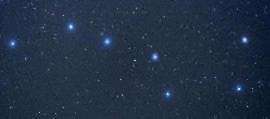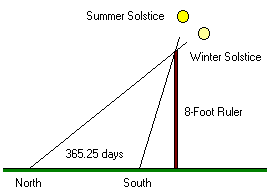Why Yin Yang Symbol
 looks
like this way? looks
like this way? |
Where does the Yin Yang Symbol come from?
 is a well-known Chinese Yin Yang symbol. Sometimes it's called Tai-Chi symbol.
The Tai-Chi is from I-Ching. The I-Ching is the greatest foundation of Chinese philosophy.
Itís development is from the natural phenomena of our universe. Because I-Ching comes from nature, it should be
easy.
is a well-known Chinese Yin Yang symbol. Sometimes it's called Tai-Chi symbol.
The Tai-Chi is from I-Ching. The I-Ching is the greatest foundation of Chinese philosophy.
Itís development is from the natural phenomena of our universe. Because I-Ching comes from nature, it should be
easy.
The Chinese characters of I-Ching
are ![]() . The second character means a
book, a profound book. The first character means ease or change. Since I-Ching is
easy, some people call it as "The Book of Ease" or "The Book of Changes". The original Chinese character of
. The second character means a
book, a profound book. The first character means ease or change. Since I-Ching is
easy, some people call it as "The Book of Ease" or "The Book of Changes". The original Chinese character of ![]() is
is ![]() ,
which is a symbol combining the sun (top) and moon (bottom). It's easy
for people to understand the philosophy by talking about the sun (Yang), moon
(Yin) and universe. After observing the universe, ancient Chinese found that the universe is changing every day. Although it changes easily every day, it also has seasonal and annual cycles. From these cycles the unchanging rules are created. However, it's not easy to use the
,
which is a symbol combining the sun (top) and moon (bottom). It's easy
for people to understand the philosophy by talking about the sun (Yang), moon
(Yin) and universe. After observing the universe, ancient Chinese found that the universe is changing every day. Although it changes easily every day, it also has seasonal and annual cycles. From these cycles the unchanging rules are created. However, it's not easy to use the ![]() method to find the unchanging rules from the universe and apply on human
activities. That's why some people think I-Ching is easy and some don't.
method to find the unchanging rules from the universe and apply on human
activities. That's why some people think I-Ching is easy and some don't.
|
|
By observing the sky, recording the Dipper's positions and watching the shadow of the Sun from an 8-foot (Chinese measurement) pole, ancient Chinese determined the four directions. The direction of sunrise is the East; the direction of sunset is the West; the direction of the shortest shadow is the South and the direction of the longest shadow is the North. At night, the direction of the Polaris star is the North. They noticed the seasonal changes. When the Dipper points to the East, it's spring; when the Dipper points to the South, it's summer; when the Dipper points to the West, it's fall; when the Dipper points to the North, it's winter.
|
When observing the cycle of the Sun, ancient Chinese simply used a pole about 8 feet long, posted at right angles to the ground and recorded positions of the shadow. Then they found the length of a year is around 365.25 days. They even divided the year's cycle into 24 Segments, including the Vernal Equinox, Autumnal Equinox, Summer Solstice and Winter Solstice, using the sunrise and Dipper positions.
They used six concentric circles, marked the 24-Segment points, divided the circles into 24 sectors and recorded the length of shadow every day. The shortest shadow is found on the day of Summer Solstice. The longest shadow is found on the day of Winter Solstice. After connecting each lines and dimming Yin Part from Summer Solstice to Winter Solstice, the Sun chart looks like below. The ecliptic angle 23 26' 19'' of the Earth can be seen in this chart.
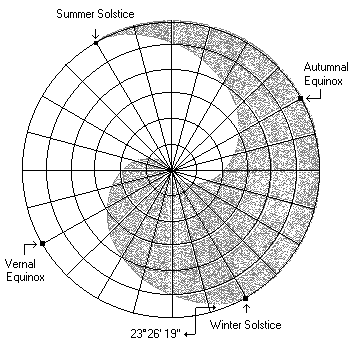
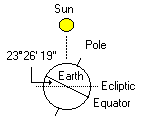 |
The Ecliptic is the Sun's apparent path around the Earth. It's tilted relative to the Earth's equator. The value of obliquity of the Ecliptic is around 23 26' 19'' in year 2000. |
By rotating the Sun chart and positioning the Winter Solstice at the bottom, it will look like
this  .
The light color area which indicates more sunlight is called Yang (Sun). The dark color area
has less sunlight (more moonlight) and is called Yin (Moon). Yang is like man. Yin is like
woman. Yang wouldn't grow without Yin. Yin couldn't give birth without
Yang. Yin is born (begins) at Summer Solstice and Yang is born (begins) at Winter Solstice.
Therefore one little circle Yin is marked on the Summer Solstice position.
Another little circle Yang is marked on the Winter Solstice position. These two little
circles look like two fish eyes.
.
The light color area which indicates more sunlight is called Yang (Sun). The dark color area
has less sunlight (more moonlight) and is called Yin (Moon). Yang is like man. Yin is like
woman. Yang wouldn't grow without Yin. Yin couldn't give birth without
Yang. Yin is born (begins) at Summer Solstice and Yang is born (begins) at Winter Solstice.
Therefore one little circle Yin is marked on the Summer Solstice position.
Another little circle Yang is marked on the Winter Solstice position. These two little
circles look like two fish eyes.

In general, the Yin Yang symbol is a Chinese representation of the entire celestial phenomenon. It contains the cycle of Sun, four seasons, 24-Segment Chi, the foundation of the I-Ching and the Chinese calendar.
© Copyright 1999- Allen Tsai
More about What is Chinese Yin Yang?
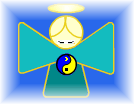
Chinese Astrology - Love, Money, Fame and Career
Origionator: https://www.chinesefortunecalendar.com/YinYang.htm
